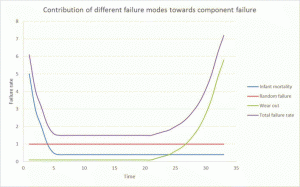
A pressure sensor plays a key role in the instrumentation of machinery and processes. When sensors fail, the process often fails, with sometimes costly or even fatal consequences. That leads us to the obvious question of why pressure sensors fail. Sensor failures in the field can be broken down into four broad categories:
1. Manufacturing defects caused by faulty materials or poor workmanship
Those incidents, often referred to as DOA (Dead on Arrival), OOB (Out of Box) failure, or zero miles failures, are very rare as any reputable manufacturer has QA systems in place to prevent major production defects. Moreover, as the products typically require several assembly and calibration stages, most defects are caught at component or sub-assembly level before even getting to the final inspection stage. Products passing the final inspection but failing during transit should only occur at a single digit dpm (defects per million) rate.
2. Defects caused by premature failure in the field and covered by the manufacturer’s warranty
Products failing during the warranty period (typically 12-24 months) are also considered faults caused by faulty materials or poor workmanship. Depending on the complexity of a product, the number of incidents during a 1- 2 year interval can be in the range from 100 up to 1000 dpm. This is related to the complexity of the product – the number of components and the number of process steps involved in manufacturing the product – and is directly related to the process design quality and the manufacturer’s ability to control manufacturing processes. As a rule of thumb, the risk rises with the number of components, connections and functions involved in the manufacturing process. Passive, mass-manufactured sensors (e.g. a WIKA SCT-1) achieve dpm rates in the single digit to low double digit range. Conventional (analog) pressure sensors (e.g. the WIKA MH-2) in serial production of several hundreds to thousands achieve dpm rates in the low hundreds range. It is difficult to get more complex instruments such as smart transmitters that incorporate digital circuitry, micro-processors, and displays below the 1000 dpm threshold consistently.
3. Random failures that just happen over time
Once a product has “survived” installation and is actually used, the so called “random failure rate” applies. The random failure rate is typically expressed as the MTTF (Mean Time to Failure) in years. MTTF is directly related to the design of the product (number of components, complexity of components and applied stress level). It is a statistical parameter used to compare different designs with regard to the expected random failure rate during the useful lifespan. A MTTF of 100 years does not mean that the product will last 100 years, but if you have 100 units of this product operating under the same conditions you can expect one of them to fail per year as a result of random component failure.
4. Field failures caused by aging and “wear and tear”
Sensors operating in the field after the first couple of years typically continue to function for a very long time because the random failure rate is typically very low (i.e. the MTTF of pressure sensors is typically several hundred years) In fact, as state of the art electronic pressure sensors do not contain any mechanical parts that are subject to “wear and tear,” a well-designed pressure sensor is expected to last hundreds of millions of load cycles without any significant sign of aging or drift. Most users will not experience any “aging” or age related failure over the typical lifespan of 5 – 15 years. Pressure sensor typically “die” in the field because of mechanical damage, electrical overload (like lightning or misconnection during inspections/repair work) or, most commonly, damage by over-pressure, pressure spikes or ingress of moisture/chemicals into the product. Keep in mind that the large majority of the damage to sensors caused by the user/application can be prevented by selecting the right product for the job.  Figure 1: Three different elements contribute to the “bathtub” curve: but only the “random failure rate” (red) is covered by MTTF value and remains constant over time.
Figure 1: Three different elements contribute to the “bathtub” curve: but only the “random failure rate” (red) is covered by MTTF value and remains constant over time.
Preventing Pressure Sensor Failure
The most common cause for pressure sensors failing in the field is using the wrong sensor for the job. A careful selection process and a review of the relevant literature (or consultation with competent engineers and manufacturer reps) can prevent most of these failures. The WIKA Technical Support Group is more than happy to answer any question you may have about pressure sensor failure or how to make sure you’ve got the right sensor for the job.
Contributing Blogger: Eugen Gassmann Eugen Gassmann has more than 20 years of experience in the sales and marketing of industrial sensors, instrumentation solutions and automation systems. Gassmann, who wrote the book “Electronic Pressure Measurement,” regularly speaks at industry conferences about product management for industrial products in the B2B world. He has a degree in electronics from the University of Applied Science in Karlsruhe, Germany. He has worked for other global organizations, including Philips Electronics and Sartorius.

